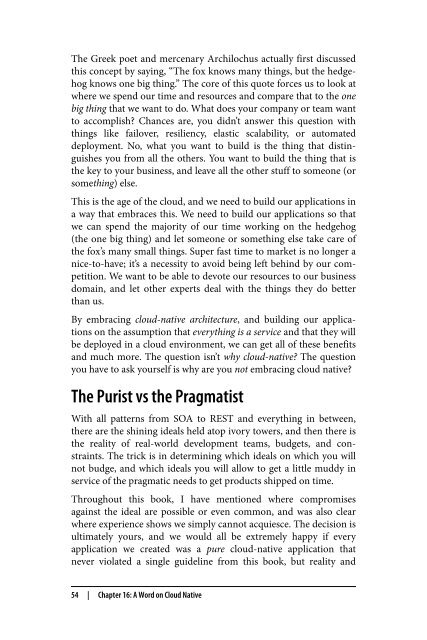Beyond the Twelve-Factor App
beyond_the_12-factor_app_pivotal
beyond_the_12-factor_app_pivotal
You also want an ePaper? Increase the reach of your titles
YUMPU automatically turns print PDFs into web optimized ePapers that Google loves.
The Greek poet and mercenary Archilochus actually first discussed<br />
this concept by saying, “The fox knows many things, but <strong>the</strong> hedgehog<br />
knows one big thing.” The core of this quote forces us to look at<br />
where we spend our time and resources and compare that to <strong>the</strong> one<br />
big thing that we want to do. What does your company or team want<br />
to accomplish? Chances are, you didn’t answer this question with<br />
things like failover, resiliency, elastic scalability, or automated<br />
deployment. No, what you want to build is <strong>the</strong> thing that distinguishes<br />
you from all <strong>the</strong> o<strong>the</strong>rs. You want to build <strong>the</strong> thing that is<br />
<strong>the</strong> key to your business, and leave all <strong>the</strong> o<strong>the</strong>r stuff to someone (or<br />
something) else.<br />
This is <strong>the</strong> age of <strong>the</strong> cloud, and we need to build our applications in<br />
a way that embraces this. We need to build our applications so that<br />
we can spend <strong>the</strong> majority of our time working on <strong>the</strong> hedgehog<br />
(<strong>the</strong> one big thing) and let someone or something else take care of<br />
<strong>the</strong> fox’s many small things. Super fast time to market is no longer a<br />
nice-to-have; it’s a necessity to avoid being left behind by our competition.<br />
We want to be able to devote our resources to our business<br />
domain, and let o<strong>the</strong>r experts deal with <strong>the</strong> things <strong>the</strong>y do better<br />
than us.<br />
By embracing cloud-native architecture, and building our applications<br />
on <strong>the</strong> assumption that everything is a service and that <strong>the</strong>y will<br />
be deployed in a cloud environment, we can get all of <strong>the</strong>se benefits<br />
and much more. The question isn’t why cloud-native? The question<br />
you have to ask yourself is why are you not embracing cloud native?<br />
The Purist vs <strong>the</strong> Pragmatist<br />
With all patterns from SOA to REST and everything in between,<br />
<strong>the</strong>re are <strong>the</strong> shining ideals held atop ivory towers, and <strong>the</strong>n <strong>the</strong>re is<br />
<strong>the</strong> reality of real-world development teams, budgets, and constraints.<br />
The trick is in determining which ideals on which you will<br />
not budge, and which ideals you will allow to get a little muddy in<br />
service of <strong>the</strong> pragmatic needs to get products shipped on time.<br />
Throughout this book, I have mentioned where compromises<br />
against <strong>the</strong> ideal are possible or even common, and was also clear<br />
where experience shows we simply cannot acquiesce. The decision is<br />
ultimately yours, and we would all be extremely happy if every<br />
application we created was a pure cloud-native application that<br />
never violated a single guideline from this book, but reality and<br />
54 | Chapter 16: A Word on Cloud Native


